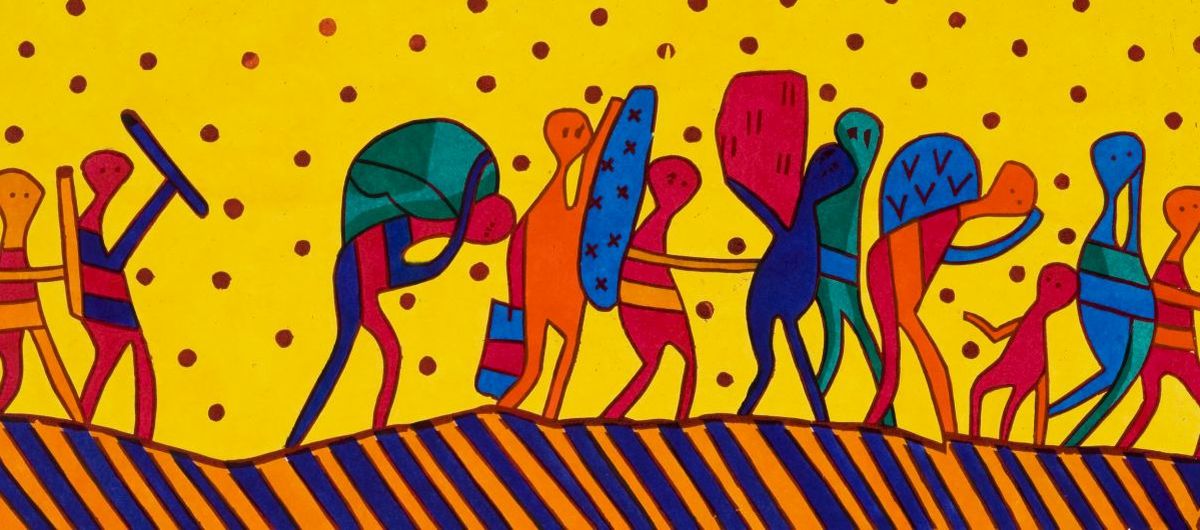Students of the pre-war Kaunas School of Art and artists who had begun their careers in an independent Lithuania, including Vytautas Jurkūnas, Algimantas Kučas, Jonas Kuzminskis, and Domicelė Tarabildienė, continued their work in graphic design under the Soviet regime. After the war, they pursued the development of trends begun in the 1930s: neoclassicism, critical realism, and expressionism rooted in folklore traditions. As ideological oversight over art increased at the end of the 1940s and at the start of the 1950s, they began creating more realistic, meticulous dry drawing engravings, but here also the illustrations by Jurkūnas for a publication of Donelaitis’ major work Metai (The Seasons) in 1956, for example, differed little from a pre-war edition by Vytautas Kazimieras Jonynas (published in 1940).
An exhibition of Baltic graphic artwork and an accompanying conference on art theory organized in Vilnius in 1956 as part of the Soviet Union-wide preparations for the First USSR Artists’ Congress revealed that the uniqueness of the Lithuanian national graphic art style was defined by the use of crude and rudimentary form. The end of the 1950s saw a return of various interpretations of folk art. The folklorist graphic art movement was noted for the use of roughly cut wood or linoleum carvings featuring ornamentation found in traditional rural works of art and artisan engravings approximating a primitivist sketching style.
Creating book illustrations based on imagery motifs, ornamentation and passages from texts, graphic artists referenced the artistic principles of book illustration that took hold in Lithuania in the 1930s, whose origins, passed on through folk art carvings, reach back to the roots of xylography in 15th century Germany. Works by Žemaitė, Petras Cvirka and Vincas Krėvė accompanied by Soviet-era illustrations fostered a critical and rather disdainful view of that cradle of folk art, the traditional village, along with its way of life and customs. Fine examples of this include Brička by Jonas Krikščiukaitis-Aišbė, with illustrations created between 1938 and 1943 by Algimantas Kučas, and Kazys Boruta’s Baltaragio malūnas (Whitehorn’s Windmill), illustrated by Jonas Kuzminskis. Illustrations by Kučas and Jurkūnas featured scenes from the routine of everyday life, peopled by clumsy, doltish characters, expressive figure drawings reminiscent of caricature, crude proportions, and the depiction of domestic anachronisms that portrayed village life as dense and backward.
Prints of that era differed from book illustrations only in that they were based not on the work of a specific author, but on folklore, and instead of addressing the gritty prose of village life they conveyed the pathos of struggle or lyrical longing found in songs. Jonas Kuzminskis, chairman of the Soviet Lithuanian Artists’ Union from 1958 to 1982 and head of the Graphic Art Department of the Soviet Lithuanian State Art Institute (1948–1968), engraved 14 xylographs based on Lithuanian folk songs between 1960 and 1978, reworking some of them to embrace revolutionary themes. Kuzminskis, Jurkūnas and Domicelė Tarabildienė applied a socialist realist approach to the enduring, symmetrical composition style of symbolic figures found in sacred paintings crafted by village artisans and other “national” forms of expression to portray issues relevant to Soviet society of that era, crafting naive allegorical narratives, usually on the theme of world peace.
A new generation of graphic artists coming of age at the end of 1950s (many of them students of Kuzminskis, Kučas and Jurkūnas), including Albina Makūnaitė, Algirdas Steponavičius, Vytautas Valius, Aspazija Surgailienė, Birutė Žilytė, Sigutė Valiuvienė and Aldona Skirutytė, created a multitude of prints employing motifs from folk songs, stories and literary works. Often, they inserted lines of text into their imagery. Desiring to keep pace with colorism’s influence on painting, they applied gouache to give bright coloring to their wood and linoleum cliché plates. Modernist, expressive and decorative interpretations of folk art that revealed one specific element of a given folk engraving, carving, weaving or wooden chest ornamentation formed the foundation for their own individual style of expression. A characteristic common to graphic artwork of the folklorist movement was the use of ornamental fields comprised of parallel stroke marks and the use of dash strokes seen in the silhouetted figures of folk carvings, used to considerable fluid and plastic effect.




Comments
Write a comment